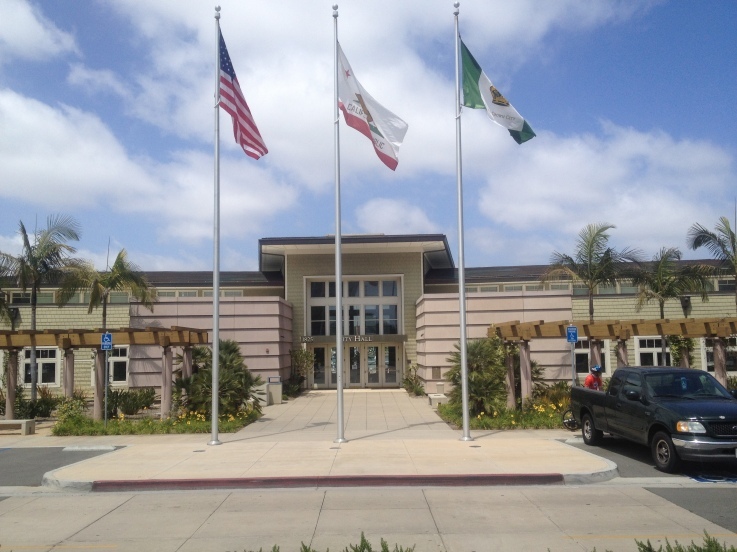The corridor between the San Diego Coronado Bridge and Orange Avenue will again dominate city council deliberations at its March 15 meeting where it will take up the following proposals:
** Consider three ways to improve safety on Third Street with left-turn prohibitions on A, B and C Avenues.
One option would be to simply post signs directing drivers to Orange Avenue and to continue prohibiting left-turns from 5am to 8am. Signage would be an easy fix, but would do little improve safety. Drivers would be free to ignore the signs and continue turning left from Third. Pedestrians and bicyclists would still find it difficult to cross at those intersections.
A more ambitious approach calls for installing permanent vehicle barriers on the south side intersections of A, B and C Avenues. Making these streets cul-del-sacs and eliminating all traffic on those blocks.
The council could also decide to consider time-specific turn restrictions with or without temporary barriers. Both would require Caltrans’s permission, an amendment to the Vehicle Code, an environmental review and a citywide referendum.
If the council chooses the latter approaches, the staff would next have to write a draft ballot initiative and bring it back to the council for approval. For such to appear on the November 2016 ballot the process would have to be completed by July.
** Evaluate three conceptual designs to slow traffic coming off the bridge and to improve the corridor’s ambiance.
The first “preserve and improve” simply adds landscaping and narrows the right-of-way. It would take about a year to complete and would cost approximately $2.8 million. The subcommittee overseeing the design process favors this option, but it also suggested expanding the scope of the concept to make the area more pedestrian and bicycle friendly.
The second option calls for demolishing all the existing structures and replacing them with a roundabout, similar to the one on Pomona, and adding aesthetic features, such as fountains, sculptures or landscaping. It would take between two and five years and would cost approximately $9.9 million.
The third and most ambitious proposal calls for replacing the toll plaza with an 11-acre park or open space area that would not only offer views of the bay, but would also allow easy access across Glorietta. Cars coming off the bridge would travel underground. It would take up to ten years to complete and would cost some $66 million.
All three would be paid for by the Toll Fund, which has money collected by Caltrans after the San Diego Coronado Bridge was paid for.
The city council will also:
** Review a California State Assembly bill (AB205), proffered by Assemblywoman Toni Atkins to relinquish SR 75 to local control.
The City of Imperial Beach is already on board. It wants to implement a Palm Avenue mixed-use master plan and believes it must gain local control to move forward. Caltrans has reviewed Imperial Beach’s request and agrees that the city is “eligible and appropriate for relinquishment,” according to the staff report.
The legislation does not include State Route 282 (Third and Fourth Streets).
There is also a bill pending in the state assembly (SB254) that would permit the state transportation Commission to “relinquish portions of the state highway system that serve only local or regional needs based on Caltrans’ recommendations.”
The state senate approved the bill last year. If the assembly concurs, the measure would not go into effect until next year and would probably not affect Atkins’ bill.
**Vote on 12-month review of the loading zones regulations in the alley between the Oxford Park Complex and the El Cordova Hotel.
This is the third time this issue has been before the council only to be continued at the last minute. In November, Councilwoman Carrie Downey said the homeowners needed more time. It was scheduled for the January 19 meeting but postponed again at the request of Oxford Park resident Betty Galba who disapproves of the current configuration. Citing pollution, noise and safety, Galbo wants delivery trucks to park on Orange or Adella Avenue.
Originally the homeowners had asked that the zones be configured so they wouldn’t block residents’ garages and still allow trucks to park in the alley. According to city staff the current locations do exactly that.
During the 12-month review there were only 11 complaints from residents: three were about noise, three about early morning deliveries and five about trucks parking illegally or blocking the alley.
The staff also conducted spot inspections and found that the zones allowed for adequate access. The report concludes that the loading zones “appear to be a success.”
The March 15 City Council meeting will be held at 4pm in the Council Chambers at the south end of City Hall.





